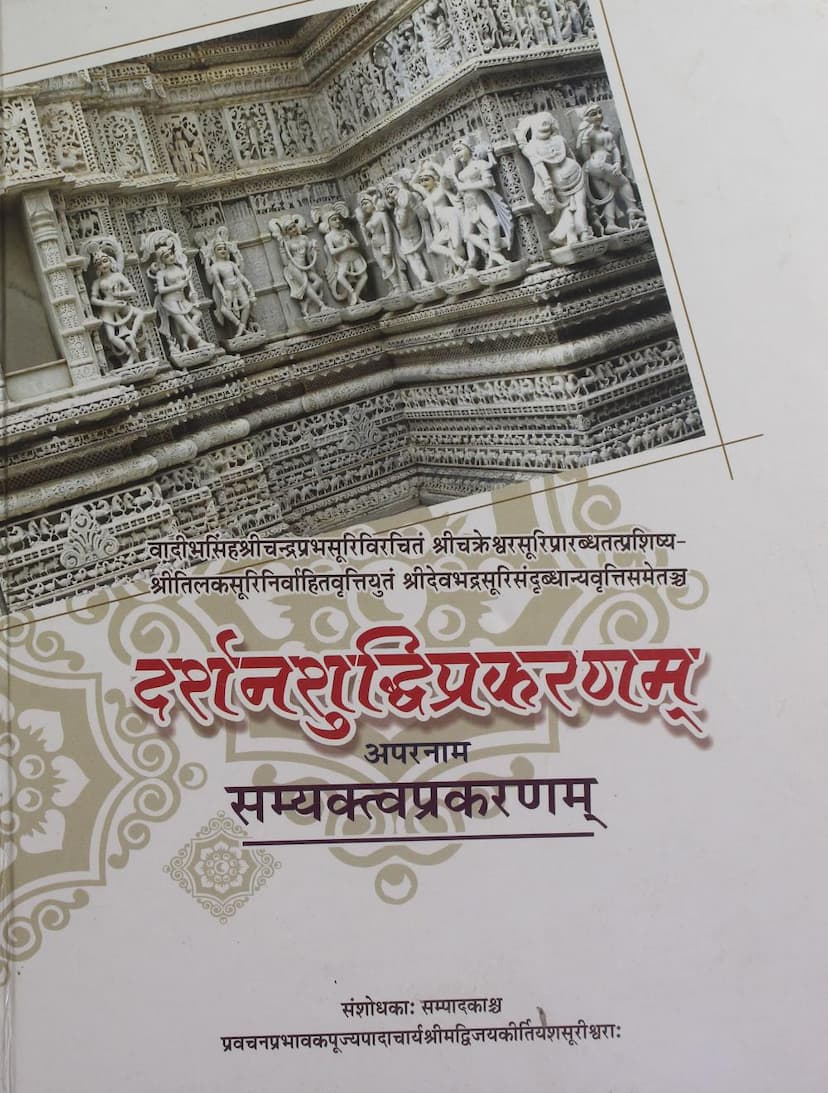Darshanshuddhi Prakaranam Aparnam Samyaktva Prakaranam
Added to library: September 1, 2025

Summary
Here's a comprehensive summary of the Jain text "Darshanshuddhi Prakaranam Aparnam Samyaktva Prakaranam" by Vijaykirtiyashsuri:
Book Title: Darshanshuddhi Prakaranam (also known as Samyaktva Prakaranam) Author: Vadihsingh Pujyacharya Shri Chandraprabhasurishvara Commentators:
- Shri Chakreshwarsuri (initiated the commentary)
- Shri Tilaksuri (completed the commentary)
- Shri Devbhadrasuri (provided an additional commentary) Publisher: Sanmarg Prakashan, Ahmedabad Series: Shasanashirataj Suri Ramchandra Diksha Shatabdhi Granthamala, No. 26 Edition: First Year of Publication: V.S. 2069 (2013 CE), coinciding with the Diksha Shatabdhi (centenary of initiation) of Acharya Shri Vijay Ramachandrasurishvara.
Core Content and Purpose:
This text is a significant Jain treatise focused on the foundational principle of Samyaktva, which translates to Right Faith, Right Knowledge, and Right Conduct, leading to Darshanshuddhi (purity of vision or perspective). The book aims to clarify and elucidate the true nature of Samyaktva, differentiating it from false beliefs and practices.
Key Philosophical and Doctrinal Points:
-
The Five-Fold Truth (Tattva Panchak): Unlike many other Jaina texts that focus on the traditional three tattvas (Deva, Guru, Dharma), this work, authored by Acharya Chandrabhadracharya, expands the scope to a five-fold truth (Tattva Panchak). This includes:
- Deva Tattva: Right understanding of divine beings, specifically the Arihant Paramatma, characterized by their eighty-four superhuman attributes (Atishayas) and freedom from eighteen defects. The text emphasizes venerating these pure souls and distinguishing them from lower forms of deities.
- Dharma Tattva: The pure nature of the soul, defined by the presence of 21 virtues, leading to true Jain dharma, encompassing both individual (Yati Dharma) and householder (Shravak Dharma) paths.
- Marga Tattva: The correct spiritual path, which the text contrasts with erroneous paths (Unmarga) promoted by misguided ascetics who deviate from Jina's teachings, often due to attachment to worldly possessions and a disregard for scriptural injunctions. It criticizes practices that deviate from the core principles of Jainism.
- Sadhu Tattva: The true nature and conduct of an ascetic, detailing the eighteen defects (Doshas) to be avoided and the necessary conduct for sustenance. It also outlines the thirty-six qualities of an Acharya.
- Tattva Tattva: The fundamental principles of reality, including the detailed explanation of the nine tattvas (Jiva, Ajiva, Punya, Papa, Asrava, Samvara, Nirjara, Bandha, Moksha), with a particular emphasis on understanding them correctly for purifying one's vision.
-
Distinction from False Views (Mithyatva): The text meticulously contrasts the purity of true vision (Darshanshuddhi) with various forms of delusion and false beliefs (Mithyatva). It criticizes the idea of worshipping deities with worldly attachments or flaws, following unscriptural paths, or adhering to erroneous interpretations of religious practices.
-
Importance of Knowledge and Conduct: The text highlights that mere intellectual knowledge without right faith (Samyaktva) and pure conduct is insufficient for liberation. It stresses the necessity of aligning one's beliefs, knowledge, and actions.
-
Emphasis on Right Conduct: The work provides detailed explanations of correct conduct (Sadachara) in various aspects of Jain practice, including the proper way to build temples, venerate idols, perform worship, observe vows, and the conduct of monks and nuns.
-
Critique of Deviations (Unmarga): A significant portion of the text is dedicated to identifying and refuting "Unmarga" – paths that deviate from the true Jain teachings, often promoted by those who lack proper understanding or are driven by personal agendas. The text cautions against following such paths, even if they appear attractive or are followed by many.
-
Commentaries and Scholarly Value: The presence of multiple commentaries by esteemed scholars like Chakreshwarsuri, Tilaksuri, and Devbhadrasuri underscores the text's depth and importance in the Jaina tradition. These commentaries provide diverse perspectives and detailed explanations, enriching the understanding of the original work. The editorial work by Vijaykirtiyashsuri, aimed at clarifying and presenting these ancient texts, is also noteworthy.
-
Context of Publication: The publication of this work is tied to the Diksha Shatabdhi (centenary of initiation) of Acharya Shri Vijay Ramachandrasurishvara. This context highlights the text's relevance to contemporary Jaina practice and the effort to revive and disseminate the profound teachings of the Jaina tradition.
Structure and Content Breakdown (as indicated by the table of contents):
The book is structured around the explanation of key tattvas and principles related to Samyaktva:
- Prakarana: Introduction and foundational explanations.
- Deva Tattva: Discussion on divine beings and their correct understanding.
- Dharma Tattva: Explanation of the true nature of Dharma.
- Marga Tattva: Elucidation of the right spiritual path and critique of wrong paths.
- Sadhu Tattva: Description of the qualities and conduct of true ascetics.
- Tattva Tattva: Detailed explanation of the fundamental realities, including the nine tattvas.
- Appendices (Parishishta):
- Bhavanuvad Sahita Darshanshuddhi Prakaranam - Samyaktva Prakaranam (A conceptual translation/explanation)
- List of verses found in various other texts.
- List of verses and commentaries used in this publication.
- Notes on specific inaccuracies in previous publications.
- List of relevant Jain scriptures.
- List of similar commentaries.
- List of stories/narratives used within the commentaries that were not included in this specific publication.
- Alphabetical index of verses.
Overall Significance:
"Darshanshuddhi Prakaranam Aparnam Samyaktva Prakaranam" is a vital text for Jains seeking a deeper understanding of Samyaktva. It offers a systematic and detailed exploration of right faith, knowledge, and conduct, emphasizing the correct path to spiritual liberation and cautioning against deviations. The work's comprehensive nature, supported by multiple commentaries and scholarly editing, makes it a valuable resource for Jaina scholars and practitioners alike.